In this first episode of Quite By Accident, 25-year-old Steve Hess, fresh out of U.S. Army service in Germany, lands a job in Eisenhower’s White House. Host Katie Dunn Tenpas finds out how that happened and gets a ground-level tour of the White House in the late 1950s.
- Listen to Quite By Accident on Apple, Spotify, or wherever you like to get podcasts.
- Watch on YouTube.
- Learn about other Brookings podcasts from the Brookings Podcast Network.
- Sign up for the podcasts newsletter for occasional updates on featured episodes and new shows.
- Send feedback email to [email protected].
- Thanks to: Kuwilileni Hauwanga, supervising producer; Fred Dews, senior producer; Gastón Reboredo, audio engineer; Daniel Morales, video editor; Colin Cruickshank, videographer; Katie Merris, art designer; Tracy Viselli and Adelle Patten, Governance Studies communications.
Transcript
[music]
HESS: I came off a plane from Germany and I’m unemployed and I need a job, and it could be any job in the world, or I could’ve worked for a congressman. I could’ve worked for a ditch digger. It doesn’t, and it turns out it’s for the president of the United States. Well, that’s a total fluke.
I didn’t plan that.
TENPAS: Stephen Hess is arguably one of the longest serving Washington insiders you’ve probably never heard of. But as veteran political commentator Chris Matthews said about Washington players, “My favorite political question is, who is in the room?” And as a White House staffer or adviser during five presidencies, Steve Hess was a good bet for the answer.
His career began unexpectedly as a speechwriter for President Dwight Eisenhower in 1958. He was 25 years old.
[music]
I’m Katie Dunn Tenpas, a visiting fellow and director of the Katzmann Initiative at the Brookings Institution, and a practitioner senior fellow at the University of Virginia’s Miller Center. And this is Quite By Accident, a podcast about Steve Hess and his life at the center of American politics.
I’ve known Steve Hess for decades myself, but as you’ll learn in this podcast, his experience in and around politics and powerful people goes back … way back.
HESS: I was born in 1933. The president of the United States was the same president, Franklin D. Roosevelt, till 1945. That’s a long period of time.
[“Hail to the Chief” plays]
When FDR ran for a fourth term, 1944, and his caravan came up Broadway in Manhattan, and we lived on 98th Street and Broadway. And I could look down and I could see FDR coming down Broadway in an open car in the pouring rain. I didn’t know it, but this was a historic moment because it was the moment when FDR was trying to convince his electorate that he was well enough to run for a fourth term, driving down in the open rain.
I didn’t know until later history, that he got to 96th Street, he took a right, went into a garage, had a rub down, took some cognac, and continued on his way. And of course, by April, he was dead. But I saw him at that moment or I saw down on him.
It was sort of an exciting time for a young man to be alive. I mean, we saved scrap metal so that our troops could make planes. We, spent our night flicking in the sky, seeing if we could identify foreign planes. If I were a little older, and I had been drafted, it wasn’t a great time at all. But we sent letters to our relatives who were in the Army. Fortunately, none of them died, but some could have. But for a young person as I think back, what a great time. We won a great war and I was there!
TENPAS: But you also were born in the midst of the Depression and most people would say, that’s not such a great time.
HESS: I know. Isn’t that something? And it is true because my father was deeply hit by the Depression. He had an automobile agency. People stopped buying cars. There were no cars to buy. So, it was tough for him until the war is over and everybody wants a car.
And my poor father dies.
[music]
TENPAS: Steve’s dad, Charles Hess, died of a heart condition when Steve, an only child, was just 13.
HESS: We didn’t have it good or bad, but we had it. He had an automobile agency. Every automobile agency has a garage. And so, there were no cars to sell, so he just moved over to the garage part where he did the accounting or whatever he did.
And, I don’t know. We didn’t, we, I don’t know. I, I, I have notes that I sent for my parents at that time, birthday cards, and I’ll say things like, “Hey, it’s gonna be a good year next year.” Or something like that.
But it is strange. You’re absolutely right that those were not great times. We did have a car because he had an automobile agency, and we would go to Van Cortland Park on a Saturday, Sunday with a picnic, and the sun was shining. And my father would say, I wonder what poor people do? We were rich people. We had a picnic.
Of course, he had been a poor person. And how clever of him to sort of hook on to the automotive industry, which is coming along as he’s a young man. And it works ultimately well enough for him. He was lucky, he was shrewd. He did that.
[music]
TENPAS: After college in the mid ‘50s, Steve was drafted into the U.S. Army. He went to serve in Germany, and wouldn’t you know it, that was the start not of a military career, but of a career in writing, history, and politics.
HESS: I’m in the Army. I’m attached to the Third Armored Division headquarters outside Frankfurt, it’s a peace army. I’m bored if I’m not on guard duty. So, I’ve got a car and I drive into Frankfurt. There is a USIA library. I think I’ll learn a little more about the Civil War. I don’t feel I know enough, so I’ll go and read a book.
So, I get to the library and I see this great big fat volume, and it’s a biographical sketch of everyone who has ever been in the Congress. So, I start going through it. Sort of interesting, you know, I was a political science major. I knew about the Roosevelts, I knew about the Adams, I knew about the Harrisons and so forth. But I’m suddenly finding families that go on for generation after generation, the Freylinghuysens. What do I know about the Freylinghuysens?
And hey, this is sort of interesting and rather than being bored, I started to write little genealogical charts of these people. When I leave the Army, I’ve got 300 of these little charts. Well, maybe they’ll come in handy someday.
And they’re not handy to anybody until along come the Kennedys. And suddenly people are sort of interested in the idea of families and they’re perfectly willing to give me a contract on a book, which is called America’s Political Dynasties: From Adams to Kennedy, which does very well.
[music]
So, I’m suddenly in business, which I hadn’t expected. I certainly wanted to write a book, but not that particular book.
TENPAS: In 2016, Steve updated this book and the Brookings Institution Press released a new edition, America’s Political Dynasties: From Adams to Clinton.
But in the late 1950s, Hillary Rodham and Bill Clinton weren’t even teenagers. Political Washington was still largely white, male, and older.
[Rev. Martin Luther King, Jr. speaking]
Congress controlled the District’s institutions, which remained segregated. And remember, this was five years before the March on Washington for Jobs and Freedom.
HESS: Well, it turned out I’m now getting out of the Army. I’ve gone to college, I’ve been drafted, I’ve been sent to Germany, I’ve been sent to home, and I’m 25 and unemployed, and getting off the boat. And it turns out just at that time, my mentor from college has been appointed the speechwriter to President Eisenhower. Wow!
TENPAS: Steve’s college mentor was Malcom Charles Moos, aka “Mac.” He joined President Eisenhower’s staff as a special assistant in 1957, and chief speechwriter in 1958. How fortunate for Steve but, it turns out, in a pretty accidental way!
[music]
HESS: So, at any rate, this professor I’m talking about, his name is name Malcolm Moos. But in 1951, I went to the University of Chicago. And I liked it fine. But 1952, in August, I visited my relatives in Baltimore. My father had come from Baltimore. And in the Baltimore Sun there’s an article that Johns Hopkins University is starting a new program that sounds great for me. You can work as fast as you want with a professor you like on a topic you like. I said, great.
I get in my car, I drive over to Johns Hopkins. And I say, Is there anybody here I could talk to in the political science department? She said, Well, Dr. Swisher, Carl Swisher, the chairman of the department, he happens to be in today. Knock on his door. Maybe he’ll talk with you.
So, I knock on his door. Carl Swisher is a great constitutional authority. So, I knock on the door. I tell him I’m sort of interested in transferring. And he says, “Name the justices of the Supreme Court.” So, I named the justices of the …
TENPAS: That was his first question of you?
HESS: Yep.
TENPAS: Not like it’s so great that you’re interested in this new program?
HESS: No, no, no, no. I told him why I was there. He says, “Name the justices of the Supreme Court,” and I name the justices of the Supreme Court. And then he says, “Name President Truman’s Cabinet.” At that time, the postmaster general was in the Cabinet. So, I get to that point and I say, Oh, Dr. Swisher, I can’t remember. Who was it? And he can’t remember either.
[music]
TENPAS: Hah!
HESS: So, the only thing he can do at that point is admit me to Johns Hopkins.
TENPAS: There was no application process, no ACT, no SAT for Steve’s admission. He just walked into Professor Carl Swisher’s office, chair of the political science department, passed an impromptu who’s who in politics quiz, and he was in.
HESS: My grandchildren today are at the age where they’re applying for college, and I think of all the things they’re doing to get into college. And I think, why can’t they do it my way? Just knock on the door.
TENPAS: You basically answered a trivia question.
HESS: Answered a trivia question.
TENPAS: Which really isn’t trivial, but …
HESS: That’s right. That’s right. So, that that was it. And the professor that becomes my mentor is Malcolm Moos, who is not only the political science professor that covers my field, he also happens to be the chairman of the Republican Party in Baltimore. Wow! And suddenly I become a Republican. He’s a moderate Republican. He comes from Minnesota, but I learned my politics from him.
TENPAS: Moderate Republican from Minnesota meant something a lot different than it means today. So, Mac Moos says to Steve:
HESS: I’d love to have you as my assistant. But he goes to Sherman Adams. Sherman Adams is the chief of staff—
TENPAS: —chief of staff in the Eisenhower White House, former congressman and governor of New Hampshire, and World War I Marine Corps veteran—
HESS: —and he was tough. He was in the same tradition that Eisenhower had Walter Bedell Smith as his, as he called him, “a bastard to his bitch, son of a bitch And Sherman Adams says, “No! He doesn’t need an assistant”
Fortunately, Sherman Adams was in big trouble at the moment because he was mixed up in a scandal with a man named Bernard Goldfine. In fact, he wasn’t going to be there very long.
TENPAS: Bernard Goldfine was a Boston textile manufacturer and real estate operator who entertained governors and members of Congress from both parties. He got his friend Sherman Adams to approach federal regulatory agencies about their investigations of his business dealings, and Adams accepted from him the gift of a vicuña overcoat and loan of an Oriental rug.
HESS: And Moos, who’s not only a professor, but a pretty shrewd politician, instead goes to the chairman of the Republican National Committee, Meade Alcorn, goes around Sherman Adams. And he says to Meade Alcorn, you know, I’m going to be writing the president’s speeches in this midterm election, I could use an assistant. And Meade Alcorn says, Sure, sure, send him over.
TENPAS: That is, Send Steve Hess over. Meade Alcorn, by the way, fired Sherman Adams, opening the door for Steve as if by accident.
HESS: So, I go to the Republican National Committee and he calls me Steve, nobody called me Steve at that level. And he said, how much would you are you going to be paid or want to be paid? Nobody ever asked me that before. They didn’t ask me that when I became a private in the Army. I don’t know why, but I say $1,000 a month. And he said, Okay. He said that too quickly, I probably didn’t ask for enough. So, I say, Well, there’ll be some expenses. I don’t know what I’m talking about, what exp….
TENPAS: You just made up the expenses?
HESS: I just made it up. I don’t know. What do you say?
TENPAS: Well, very bold.
HESS: Oh, I’m very bold, I don’t know what I’m talking about. And he says, Well, we’ll give you an apartment. Oh, my, I’ve gotta have an apartment in Georgetown.
TENPAS: In Georgetown?
HESS: Well, I did. Yeah, because I could pick the apartment myself. Sure. In fact, I should tell you that my college roommate, who is now who had just become a lawyer from Yale and was now a lowly lawyer at the Navy Department and he’s making nothing, and I’m making a thousand dollars a month. So, I invite him. And so, we had a good time.
TENPAS: So, $1,000 a month back then might have been a total of annual salary …
HESS: Wait, there’s more to it. Because I then say, now I’ve got now I’ve got $1,000 a month and an apartment. And I say, well, Meade, this is September, couldn’t you pay me through the end of the year? He says, sure. And then your point is well taken: what is it worth now? Well, we didn’t have a computer then, but now I could Google it and say, What is my salary in 1958 worth in 2023?
TENPAS: You can look this up yourself, but to save time, $12,000 a year in 1958 is about $127,000 today, which is a pretty good White House salary. Steve was 25 years old, and in Eisenhower’s White House, this put him in the company of staffers who were a lot older than he was.
…
TENPAS: I’m guessing that most of the people that you worked with were probably 35, 40, 45. What was it like working in the White House?
[music]
HESS: That’s a very interesting question, because in 1958, when I was the president’s aide, Ruth Bader Ginsburg was still in law school. John Lewis was like seven years removed from the march between Selma and Montgomery. The Stonewall riot was still a decade away. And there I was instead writing speeches in the seventh year of a presidential administration.
So, the first thing you’d think about is they’re a lot older than I am. Remember, I’m already two generations removed from the president. And when you look at the White House staff, there was actually one of my colleagues on the staff had been a classmate of Eisenhower’s at West Point: John Bragdon. He was at West Point, he was called Poopie. Well, it turned out to be an endearing word because at West Point, apparently, poopie was the stuff that they that they studied. And so he showed he was very good at the stuff he was studying.
But Poopie was on the staff with me, including people who had been CEOs of General Foods, presidents of major universities—University of North Carolina, Wesleyan State. So, I was there with a lot of older people.
In fact, of that staff, there was only one other person who was in his twenties, and he was pretty remarkable, too. His name was Phil Areeda. He was 28. And he was, as soon as the administration was finished, was about to come a professor at law at Harvard. He was an amazing person. So, I didn’t even think of him as just another kid like me. He was—
TENPAS1: —right, he was already accomplished.
HESS: Yeah. He was so accomplished at that at that time.
So, at any rate, it was more than just the people I was with. It was the setting I was with. Well where I was housed. I was in the Executive Office Building. Now the Eisenhower Building, that great pile of bricks right next to the West Wing of the White House.
[music]
TENPAS: Let’s pause here and think about the White House itself, where it sits in Washington, D.C., the constellation of buildings around it. You might know it today as a veritable fortress—the roads that bound it north and south closed to vehicle traffic after 9/11, high fences surrounding the perimeter, guards you can see and probably more guards that you can’t see.
But, what was it like for a 25-year old who was just starting out there, who had never visited the people’s house before? As Steve said, his office was in what’s now called the Eisenhower Executive Office Building, formerly known as the Old Executive Office Building. It was built in the decades after the Civil War to house the State, War, and Navy Departments. Mark Twain supposedly called it “the ugliest building in America.” Harry Truman said it was “the greatest monstrosity in America.” But I think it is charming and it’s now a National Historic Landmark.
HESS: My office looked down on the South Lawn. I could see it if a helicopter was coming in and Eisenhower was getting off and holding his hat and so forth. I could see them putting up little candy-covered tents if Mrs. Eisenhower was having a party. I could see people going in that West Wing door who wanted to get away from the press. So, it was really an exciting view.
TENPAS: Steve’s speechwriting office was in the Executive Office Building, but he could walk just a short distance to the White House, entering through its famous West Wing to get to Malcom Moos’ office on the other side. What was that like, I wondered?
HESS: And my typical day was so incredibly interesting because there I was next to the West Wing. But Mac Moos, my boss, he was in the East Wing. So, every day, not only did I go down the elevator from the second floor, walk across West Executive, get into West Executive into the building, but I had to walk entirely through the White House to get to the other end.
TENPAS: Was there much security?
HESS: None! I mean virtually none! That is a very interesting question, because later when I would go to visit the White House, you were drenched in security. Everybody knew me. I knew everybody. I walked through that. And there’s the president hitting the golf balls. I don’t know anything about golf—
TENPAS: —He had a putting green there?
HESS: No, no, he was driving it. I walked up to his Secret Service man, I said, “Excuse me, I don’t play golf, what’s the president doing?” Well, he’s got a nine iron and he’s driving. And, I say, it looks pretty good. He hits about 80. It’s all informal like that. Everybody seems to know me. I’m not going through anything.
So, I go up to one floor. Once I’m there alone with the secretary of state, he’s just come back from Geneva, and you have a chance to ask one question. And I say, did you have a nice meeting? And I think, What a jerk, I had one question to the secretary of state.
TENPAS: —blew it!—
HESS: —and that’s what I asked.
[music]
HESS: So, you’re now you’re now on the first floor. There’s the Oval Office, the president’s office. Later, when I came back under Nixon, his secretary called me and said, Who were Eisenhower’s friends? And I said, Why are you asking? She said, Well, Eisenhower left all these marks from his golf shoes. And so, we’re going to rip up the carpet and put in new carpet. And we thought with the old carpet, we would cut it up in pieces and give it as souvenirs to his old friends. Okay, so that’s it.
There’s the room that’s now called the Roosevelt Room, which we call the Fish Room at that time, because that’s where the Roosevelt had his aquarium.
TENPAS: That’s where the staff would get briefings from the CIA every other morning on events in the world.
[music]
HESS: And if I keep going from there, I’m walking through a street that goes along the side of the Oval Office. That’s sort of like an outdoor colonnade, and this is what I’m going to be taking across to the East Wing. And that’s where I see the president hitting the golf in the South Lawn.
And if it’s raining, I go through the residence. If I go through the residence, sometimes I’m tripping over toys because the president’s grandchildren are there. And I always tell that story. Susan Eisenhower sort of became a friend of mine later. She was always furious with my telling that same damn story about how the grandchildren left their toys out and we tripped over them.
But if I’m going through on the outside, I would see Mamie Eisenhower’s Rose Garden on the right. On the left, there would be a door leading to the swimming pool.
TENPAS: Oh, wow.
HESS: And the swimming pool was reserved for women 9 to 11. The rest of the time we could use the swimming pool. I did it once just so I could say I swam in the pool because that wasn’t my thing. And I remember how hot it was. About 90 degrees. It wasn’t very attractive. Although Jack Kennedy, when he came in his father donated a great big portrait of Hyannis Port for the wall.
TENPAS: And that long pool room where Franklin Roosevelt swam daily and subsequent presidents also swam, was converted in 1969 by President Nixon to a press briefing room. Apparently, a computer server room now occupies the pool space. In 2000, it was named in honor of President Reagan’s press secretary James Brady, who was wounded in the assassination attempt on President Reagan.
HESS: And what’s interesting is if the president had been watching a movie, the cans of film would be lined up outside.
TENPAS: Cans of film?
HESS: Film. Yeah. Because they had been watching a movie. And I’m fascinated by what they’ve been watching …
TENPAS: So, you’re snooping a look at the titles?
HESS: Oh, I rush over to see what they’d been watching—“Gunfighters of Abilene.” He loved westerns. In fact, I asked the projectionist who said that in the eight years he was there, he had said seen 200 Westerns.
TENPAS: Wow.
HESS: Yeah, he was big on Westerns. War movies didn’t appeal to him much, particularly if there was something that was going wrong. And then he got mad. He didn’t like “Sergeant Bilko” at all, I’m told.
HESS: His favorite movie, according to Jim Hagerty, was something called “Angels in the Outfield”—
TENPAS: —James Hagerty was President Eisenhower’s press secretary all eight years; “Angels in the Outfield” starring Paul Douglas and Janet Leigh came out in 1951.
HESS: I think it was the Pittsburgh Pirates and the manager who was not a good guy. But he gets vision from above and he changes and he wins all the games. “Angel in the Outfield.” And he liked that one at a lot.
But the best one … it was Pete Aurand, who was his naval aide. So, he had something to do in charge of Camp David. And he told me that when the president was there with the with Prime Minister Macmillan of Great Britain, they showed a movie called “The Mouse that Roared.” Remember the movie, “The Mouse that Roared”?
TENPAS: I don’t remember “The Mouse that Roared,” a 1959 British satirical comedy starring Peter Sellers.
HESS: What happened was some little country decides to make war in the United States, knowing that they’ll lose, and as a product of their loss they’re going to be well-fed and taken care of. And so, the president and the prime minister loved that. And, in fact, the president loved it so much that he’d seen it again.
TENPAS: So, imagine Steve Hess, again, just 25 years old, joining the White House staff as a speechwriter in the last half of the second term of President Dwight D. Eisenhower,
[music]
and walking around the grounds, the West Wing, the East Wing, poking into the president’s movie habits.
TENPAS: That’s a nice walk you have every day.
HESS: It’s a nice walk, yeah. And I bump into people along the way. You know, somebody is painting the White House and I’d talk to them and they tell me what color they’re using. You know, I’m pretty nosy when you get down to it. But people love to talk to me.
TENPAS: And can we back up a second. I’m just sort of curious how a 25-year-old makes a conversation with a former CEO of a Fortune 500 company?
HESS: Oh, I don’t know. You think about it—
TENPAS: —everybody was just nice and welcoming.
HESS: Well, that was a very interesting thing, how nice people were to me. And I think they may have thought of me as sort of a substitute nephew or something like that.
For instance, Clarence Randall, who had been the president of Inland Steel. Truman had the steel strike in 1948, it was Clarence Randall who defended the steel company. So, he was the one who spoke on television. And 50 million people watched him. He really liked me.
So, there was a few days where they were remodeling the staff mess. And he would take me to the Metropolitan Club—
TENPAS: —wow—
HESS: —and he would tell me stories that weren’t in his memoirs and that sort of thing.
Or then there was another fellow: Earl Chesney. Earl Chesney had gotten there as an usher under Herbert Hoover. And he drew a great big cartoon portrait of me. It wasn’t very good. But it still was a nice gesture. Why were these people always doing these nice things for me?
TENPAS: Of course, Steve didn’t get hired to walk around and have people be nice to him. He was hired as a speechwriter, and that’s the subject of our next episode.
Stay tuned.
[music]
Thank you for listening to Quite by Accident, a podcast from the Brookings Podcast Network. I’m Katie Dunn Tenpas at Brookings and the University of Virginia.
I’d like to thank Kuwilileni Hauwanga, supervising producer; Fred Dews, senior producer; Gastón Reboredo, audio engineer; Daniel Morales, video editor; Colin Cruickshank, videographer; Katie Merris, who designed the cover art; and Tracy Viselli and Adelle Patten from Governance Studies.
A very special thanks to my dear friend and colleague Steve Hess.
Additional support for the podcast comes from colleagues in Governance Studies and the Office of Communications at Brookings.
The Brookings Institution is committed to quality, independence, and impact.
We are supported by a diverse array of funders. In line with our values and policies, each Brookings publication represents the sole views of its author(s).

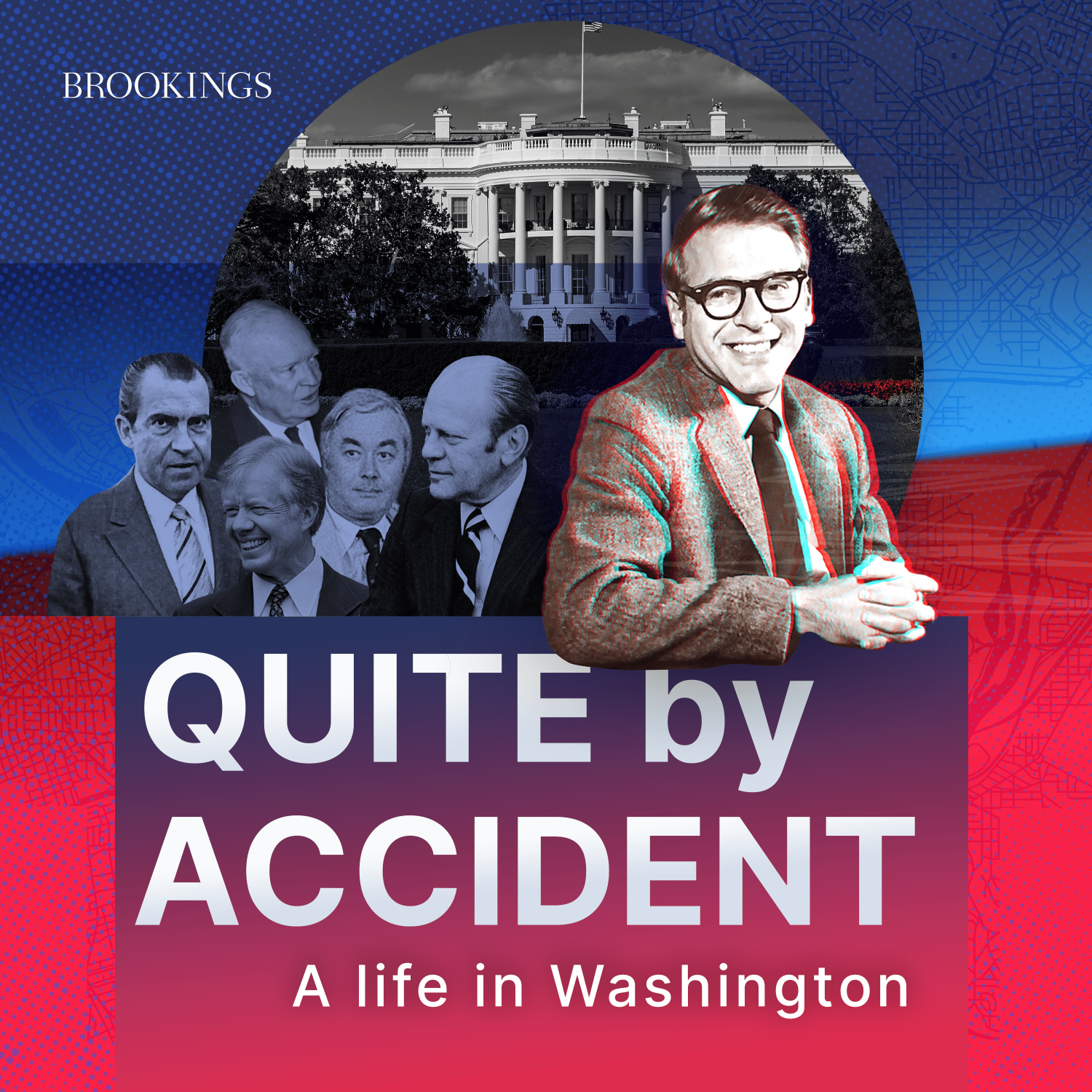
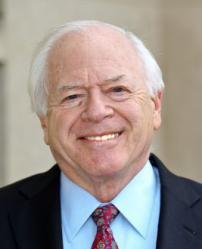
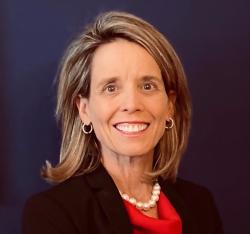
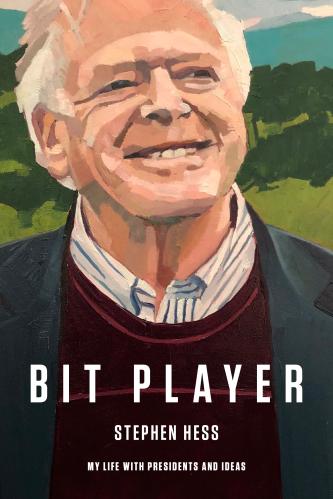
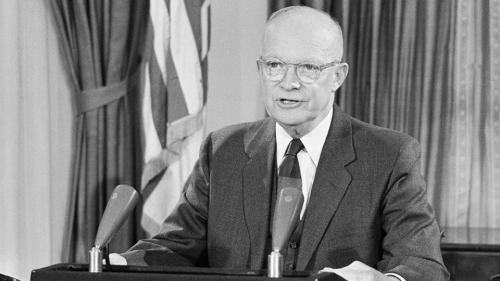



Commentary
PodcastEpisode 1: How Steve Hess got a job in Eisenhower’s White House
December 14, 2023
Listen on
Quite By Accident Podcast